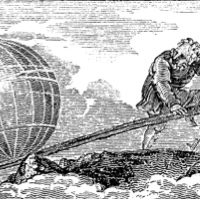Archimedes is reported to have said, lo, these more-than-two-millennia ago, that if he were given a sufficiently long lever, he, personally, could move the earth.
Now, according to some enterprising internet wonks, it turns out that Archimedes’ lever would have to be something like ten million light years long if his fulcrum was set one meter in from where the lever contacted the earth. That length will vary as we adjust some of the assumptions we have to make, but, in any case, we’re talking about putting Archimedes at the end of a lever extended considerably further out into space than the nearest galaxy, and asking him to push his end of the lever a distance of several million light years in order to move the earth a millimeter or two. Among the other problems, Archimedes would have to push his end of the lever at the speed of light for ten thousand years.
There are at least two interesting things to note about this little engineering exercise. One, what Archimedes said is indubitably true. Two, the lever doesn’t—in fact, without a quantum event of almost infinite improbability, can’t—exist.
Actually, there’s a third thing: Archimedes’ truth coexists in perfect comfort with its absurdity. We are, indeed, Thomas Browne’s amphibia, disposed and able to accommodate facts and dreams that contradict each other. It even seems that we can’t help it. In the grip of sheer science, we find we must create, to give fair form to what is so so sure, solid, and light. So, Archimedes dreams an impossible lever, and speaks it, and it is true and untrue at the same time, both here and not here, real and fiction, and we find ourselves perfectly comfortable with both.
Not only a sharply scientific notion, then—Archimedes’ preposterous lever. It’s a brashly religious noun. The being and beauty of it is not its material existence, shifting the cosmos, changing the unity of which it is a part, but its lightning-bright revelation that it is and is not—a thing, a giant, silly, imponderable, ponderous thing.
Je proteste, you might say, if you want to be polite and you feel like objecting in French is less confrontational. It’s not a lever that Archimedes discovered, but qualities of matter and energy. After all, if you’re a wonk, you can make the calculations and show that it’s all perfectly sensible without any material object at all. Indeed, I concede, the lever was only an imaginative construct useful as shorthand for the complex ways in which the stuff in the material universe rolls around.
And life is just so complex. It’s not that visions so strange as Archimedes’ lever must exist, but that they can. The stuff of life rolls around in such exquisite, harsh force and warps itself in ways that so blind and baffle us, the imaginative constructs that cannot exist, nevertheless do, and help us see everything and ourselves in it.
I suppose one could do the calculation. Make a few assumptions and sharpen your pencil and you could, perhaps, plot the necessary length of loving kindness needed to move the earth, the time over which the charity must be exerted, the distance the world would shift. And, surely, you’d have a grand, stunning figure when you finished, with an undeniable elegance of its own.
The calculation might just show us, in the way the daring math of Archimedes’ lever does, just how elegantly, truly, the imaginative construct can express the calculation. Angels, devas, god, if you must, the Eucharist, the Buddha’s tooth, Temple Mount and Amritsar, the Night Journey, Eden, Dasaswamedh Ghat over the early, golden water, the Sermon on the Mount and the Gita and Job, and, yes, Moroni, heavenly mothers, and a million more imaginings show out the shining, weighty computation. They gleam, these imaginings, with truth as true as numbers.
All truth, they might show, but this truth, at least, for which religion’s great, grand fiction speaks: If you gave me a heart big enough, and a place to stand, by gum, I could move the world.












